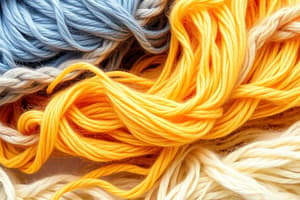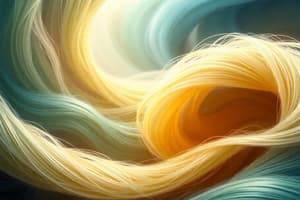Podcast
Questions and Answers
Which characteristic is NOT essential for fibers to be spun into yarn?
Which characteristic is NOT essential for fibers to be spun into yarn?
- Flexibility
- Color consistency (correct)
- Length of at least 5 millimeters
- Sufficient strength
What are the methods by which textile fibers can be formed into fabrics?
What are the methods by which textile fibers can be formed into fabrics?
- Baking and drying
- Weaving and knitting (correct)
- Painting and dyeing
- Cutting and gluing
Which of the following properties is considered important for textile fibers?
Which of the following properties is considered important for textile fibers?
- Uniformity (correct)
- Chemical reactivity
- Electromagnetic interference
- Thermal conductivity
What is defined as a unit of matter that forms the basic element of fabrics?
What is defined as a unit of matter that forms the basic element of fabrics?
In text classification, which term does NOT relate to methods of fabric creation?
In text classification, which term does NOT relate to methods of fabric creation?
Which characteristic of fiber indicates that it is capable of returning to its original shape after being stretched?
Which characteristic of fiber indicates that it is capable of returning to its original shape after being stretched?
Which of the following is NOT a basis for the classification of fibers?
Which of the following is NOT a basis for the classification of fibers?
Which type of fiber is classified as a natural fiber that comes from plants?
Which type of fiber is classified as a natural fiber that comes from plants?
What type of fiber is characterized by being a slender threadlike structure?
What type of fiber is characterized by being a slender threadlike structure?
Which characteristic is essential for fiber's ability to interact with dye stuff?
Which characteristic is essential for fiber's ability to interact with dye stuff?
Flashcards are hidden until you start studying
Study Notes
Fiber
- Fiber is defined as a delicate, hair-like portion of plant, animal, or other substances that are very small in diameter in relation to their length.
- A fiber is several hundred times longer than it is thick.
Textile Fiber
- A textile fiber is a fundamental unit of matter, either natural or manufactured.
- Textile fibers are the basic element of fabrics and other textile structures.
Fiber Classification
- Fiber classified by origin: Natural Fibers, Man Made Fibers, Vegetable Fibers, Animal Fibers, Mineral Fibers, Regenerated Fibers, Non-Cellulosic Polymer Fibers (Synthetic Fibers), Metallic Fibers, Rubber Fibers
- Fiber classified by length: Filaments (slender threadlike fiber), Staple Fibers
- Fiber Classified by Conductivity: Thermoplastic fibers, Non-Thermoplastic fibers
Characteristics of Fiber
- Fibrous formation is essential
- Length is thousands of times longer than its diameter
- It must have the ability to be spun
- Sufficient strength and spinning ability are also essential
- Contains elasticity and flexibility characteristics
- Fineness is an important characteristic
- Special color is a characteristic of fiber
- Affinity to dye stuff is a characteristic
Natural Fiber
- Natural fibers can be classified as Cellulosic, Protein, and Mineral
Cellulosic Fiber
- Plant fibers are categorized into Seed, Bast/Stem, and Leaf
- Plant fiber is classified into soft fibers and hard fibers
- Soft fibers are processed through a laborious process to remove them from plants.
- The plants are selected and harvested, partially dried, then pounded with a mallet.
- Hard fibers are subjected to a process of cutting, drying, cleaning, and soaking.
Plant Fiber
- Major commercially used plant fibers: Cotton, Coir, Kapok, Flax, Hemp, Ramie, Bamboo, Banana, Jute, Abaca, Sisal, Pineapple
Seed Fibers
- Cotton: almost pure cellulose, soft, breathable, 10 to 65 mm length, 11 to 22 microns diameter, absorbs moisture.
- Coir: stronger than cotton but less flexible, not suitable for dyeing, low tensile strength, good resistance to microbial action and saltwater damage.
- Kapok: light, brittle, elastic, lustrous, white or pale yellow in color.
Bast Fibers
- Flax: cellulose polymer, more crystalline structure than cotton, stronger, crisper, stiffer and more easily wrinkled.
- Hemp: long, strong, durable, 70% cellulose, low lignin content.
- Ramie: low elasticity, dyes easily.
- Bamboo: Soft, Drapeable, Smooth, Luxurious to the touch, Good Breathability, Cool and Comfortable to wear, Anti-static, Strong, Durable, Abrasion resistant.
- Banana: Enhanced tensile strength and modulus, low density, strong moisture absorption, good fire resistance, light weight, low elongation at break.
- Jute: long, soft, shiny, 1m to 4m in length, 17 to 20 microns in diameter.
- Abaca: strong, buoyant, resistant to saltwater damage, long fiber length (up to 3m), fine, lustrous, light beige and strong.
Leaf Fibers
- Sisal: lustrous, creamy white color, up to 1m length, 200 to 400 microns diameter, coarse, hard fiber, unsuitable for textiles and fabrics.
- Pineapple: white, creamy, lustrous, silky fiber, 60 cm long, easily retains dyes
Animal Fibers
- Animal fibers are classified as Hair, Wool, and Filament
- Alpaca: partly hollow, 20 to 70 microns in diameter, comes in 22 natural colors.
Studying That Suits You
Use AI to generate personalized quizzes and flashcards to suit your learning preferences.




